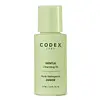What's inside
What's inside
 Key Ingredients
Key Ingredients

 Benefits
Benefits

 Concerns
Concerns

 Ingredients Side-by-side
Ingredients Side-by-side

Borago Officinalis Seed Oil
EmollientSalvia Hispanica Seed Oil
MoisturisingPolyglyceryl-4 Oleate
EmulsifyingRibes Nigrum Seed Oil
EmollientAvena Sativa Kernel Oil
Skin ConditioningPentylene Glycol
Skin ConditioningTocopherol
AntioxidantHelianthus Annuus Seed Oil
EmollientRosmarinus Officinalis Leaf Extract
AntimicrobialCitrus Nobilis Peel Oil
MaskingAnthemis Nobilis Flower Oil
MaskingSalvia Sclarea Oil
MaskingMyrtus Communis Oil
MaskingAmyris Balsamifera Bark Oil
MaskingLimonene
PerfumingLinalool
PerfumingBorago Officinalis Seed Oil, Salvia Hispanica Seed Oil, Polyglyceryl-4 Oleate, Ribes Nigrum Seed Oil, Avena Sativa Kernel Oil, Pentylene Glycol, Tocopherol, Helianthus Annuus Seed Oil, Rosmarinus Officinalis Leaf Extract, Citrus Nobilis Peel Oil, Anthemis Nobilis Flower Oil, Salvia Sclarea Oil, Myrtus Communis Oil, Amyris Balsamifera Bark Oil, Limonene, Linalool
Caprylic/Capric Triglyceride
MaskingPEG-40 Sorbitan Peroleate
EmulsifyingPrunus Armeniaca Kernel Oil
MaskingTocopherol
AntioxidantTocopheryl Acetate
AntioxidantAscorbyl Palmitate
AntioxidantCitrus Aurantium Dulcis Peel Oil
MaskingHelianthus Annuus Seed Oil
EmollientDicaprylyl Carbonate
EmollientBorago Officinalis Seed Oil
EmollientCitrus Paradisi Peel Oil
MaskingCitrus Nobilis Peel Oil
MaskingRosmarinus Officinalis Leaf Extract
AntimicrobialAleurites Moluccanus Seed Oil
Skin ConditioningCymbopogon Citratus Leaf Oil
MaskingLavandula Hybrida Oil
EmollientOryza Sativa Bran Oil
EmollientLavandula Angustifolia Oil
MaskingC12-15 Alkyl Benzoate
AntimicrobialCetyl Ethylhexanoate
EmollientCitral
PerfumingLimonene
PerfumingLinalool
PerfumingCaprylic/Capric Triglyceride, PEG-40 Sorbitan Peroleate, Prunus Armeniaca Kernel Oil, Tocopherol, Tocopheryl Acetate, Ascorbyl Palmitate, Citrus Aurantium Dulcis Peel Oil, Helianthus Annuus Seed Oil, Dicaprylyl Carbonate, Borago Officinalis Seed Oil, Citrus Paradisi Peel Oil, Citrus Nobilis Peel Oil, Rosmarinus Officinalis Leaf Extract, Aleurites Moluccanus Seed Oil, Cymbopogon Citratus Leaf Oil, Lavandula Hybrida Oil, Oryza Sativa Bran Oil, Lavandula Angustifolia Oil, C12-15 Alkyl Benzoate, Cetyl Ethylhexanoate, Citral, Limonene, Linalool
 Reviews
Reviews

Ingredients Explained
These ingredients are found in both products.
Ingredients higher up in an ingredient list are typically present in a larger amount.
Borago Officinalis Seed Oil is from the seeds of the starflower plant. This plant grows primarily in Europe.
This oil does not have a scent. It contains fatty acids such as linolenic acid. These fatty acids help keep skin hydrated.
Borago Officinalis Seed Oil is an antioxidant. Antioxidants help fight free-radicals. Free-radicals are molecules that may damage your skin cells.
Learn more about Borago Officinalis Seed OilCitrus Nobilis Peel Oil is an oil.
Helianthus Annuus Seed Oil is the oil derived from the seeds of a Sunflower. Sunflower seed oil is non-fragrant. It is an emollient, meaning it helps to soften the skin.
Sunflower seed oil contains many fatty acids. The fatty acids found in sunflower seeds include (from highest amount to least): linoleic acid, myristic acid, palmitic acid, stearic acid, arachidic acid, oleic acid, and linolenic acid.
These fatty acids help the skin create ceramides. Ceramides play a role in repairing the skin barrier.
Helianthus Annuus Seed Oil helps moisturize the skin. This in turn helps the skin look more rejuvenated and smoother.
Sunflowers are rich in vitamin E.
Historians believe Indigenous cultures of North America domesticated sunflowers before corn. Thus they relied on sunflower oil for a variety of uses. One such use is moisturizing skin and hair.
Sunflower seed oil may not be fungal acne safe. We recommend speaking with a professional if you have any concerns.
Learn more about Helianthus Annuus Seed OilLimonene is a fragrance that adds scent and taste to a formulation.
It's found in the peel oil of citrus fruits and other plants such as lavender and eucalyptus. The scent of limonene is generally described as "sweet citrus".
Limonene acts as an antioxidant, meaning it helps neutralize free radicals.
When exposed to air, oxidized limonene may sensitize the skin. Because of this, limonene is often avoided by people with sensitive skin.
The term 'fragrance' is not regulated in many countries. In many cases, it is up to the brand to define this term. For instance, many brands choose to label themselves as "fragrance-free" because they are not using synthetic fragrances. However, their products may still contain ingredients such as essential oils that are considered a fragrance.
Learn more about LimoneneLinalool is a fragrance and helps add scent to products. It's derived from common plants such as cinnamon, mint, citrus, and lavender.
Like Limonene, this ingredient oxidizes when exposed to air. Oxidized linalool can cause allergies and skin sensitivity.
This ingredient has a scent that is floral, spicy tropical, and citrus-like.
Learn more about LinaloolRosmarinus Officinalis Leaf Extract comes from rosemary. Rosemary is native to the Mediterranean.
While Rosmarinus Officinalis Leaf Oil can be volatile due to its fragrant properties, the fragrance components are usually removed in the leaf extract.
Rosemary Leaf Extract contains many antioxidants such as rosmarinic acid and caffeic acid. Rosemarinic acid, a compound found in rosemary leaf, has been found to help soothe skin conditions such as eczema and acne.
Learn more about Rosmarinus Officinalis Leaf ExtractTocopherol (also known as Vitamin E) is a common antioxidant used to help protect the skin from free-radicals and strengthen the skin barrier. It's also fat soluble - this means our skin is great at absorbing it.
Vitamin E also helps keep your natural skin lipids healthy. Your lipid skin barrier naturally consists of lipids, ceramides, and fatty acids. Vitamin E offers extra protection for your skin’s lipid barrier, keeping your skin healthy and nourished.
Another benefit is a bit of UV protection. Vitamin E helps reduce the damage caused by UVB rays. (It should not replace your sunscreen). Combining it with Vitamin C can decrease sunburned cells and hyperpigmentation after UV exposure.
You might have noticed Vitamin E + C often paired together. This is because it is great at stabilizing Vitamin C. Using the two together helps increase the effectiveness of both ingredients.
There are often claims that Vitamin E can reduce/prevent scarring, but these claims haven't been confirmed by scientific research.
Learn more about Tocopherol